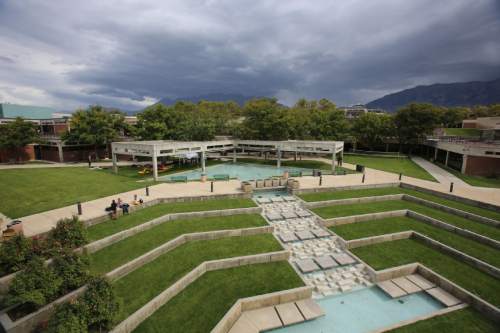This is an archived article that was published on sltrib.com in 2015, and information in the article may be outdated. It is provided only for personal research purposes and may not be reprinted.
Utah's college students are leaving free money on the table — to the tune of $45 million last year, according to some estimates.
The untouched cash — in the form of federal Pell grants — haunts state higher-education leaders. They believe the assistance could streamline college for many and make it affordable for others who consider themselves too poor to enroll.
"They can go a long way with their purchasing power," said David Feitz, executive director at the Utah Higher Education Assistance Authority. "We need to help push that affordability message."
The maximum financial-aid payout last year covered 70 percent of tuition and fees at the University of Utah.
Even so, few students seem to know how much they stand to save. Utah students are less likely to apply for help than their peers in other states. The problem is likely multi-pronged, university presidents and financial aid officers said last week at the Board of Regents' monthly conference.
Statewide, roughly one in three high school seniors in Utah fill out the Free Application for Federal Student Aid (FAFSA), according to the National Center for Education Statistics and U.S. Department of Education.
That number puts Utah dead last in the nation for its rate of FAFSA completion by graduating high-schoolers. A recent NerdWallet report found that Utah students missed out on $45.5 million in Pell grants in 2014.
Nationally, about 85 percent of students at U.S. colleges have some sort of financial assistance, according to the Department of Education. Utah college students, who tend to pay lower tuition than their counterparts nationwide, might not feel the need to apply.
In 2014, four-year college tuition averaged about $6,600 for public college students in Utah, compared with the national average of $9,139.
Despite the Beehive State's low rate of financial aid applications, some Utah colleges have significant numbers of Pell grant recipients. At Dixie State University in St. George, for example, more than half the students take advantage of the assistance — 56 percent. And it's a tight race for second place: 42 percent of Utah Valley University students in Orem have federal grants, followed by Southern Utah University in Cedar City at 41 percent and Utah State University in Logan at 40 percent.
Still, higher-education managers say Pell grants have a perception problem in Utah.
A latent distrust of the federal government, which distributes the Pell grants, prevents many Utahns from even Googling the option. Some students associate the money with welfare.
"There is some of that, for sure," said U. President David Pershing.
Some families mistakenly assume they make too much to qualify.
"People assume you have to be in dire poverty," said Higher Education Commissioner David Buhler.
Utah also is strapped for recruiters. The state's force of high school counselors is nearly a third the size recommended by the American School Counselor Association, which calls for a ratio of 250 to 1. Utah's rate is 726 to 1. Only California and Minnesota have smaller proportions, according to the Department of Education.
That's all compounded by what seems like mountains of paperwork. Filing for federal financial aid is the first step in applying for the grant, and it requires detailed tax and income information — plus relative fluency in bureaucratic jargon.
"Imagine what it takes for people who don't speak English as a first language," said Salt Lake Community College President Deneece Huftalin. "I worry about our families who are trying to do that."
The Utah System of Higher Education has taken steps to lighten the burden, hosting how-to seminars and touting student success stories.
However difficult, the slog is worth it, Feitz maintains, because there is no catch. Grants of up to $5,775 a year do not need to be repaid.
Utah's teens and 20-somethings, however loan-averse, higher-education managers said, would be wise to incur a little debt to graduate more quickly.
Statewide, one aspect of Utah culture could help more students qualify for assistance, noted newly sworn-in regent Patricia Jones. The elevated rate of young married couples means the state has many a household of two college students. Such a pair could make nearly $70,000 in combined income and still qualify, Jones said.
Students over 24 years old or who are veterans are considered "independent," which means their parents' income is not a factor. Last year, people who made up to $23,500 a year could still get the maximum Pell grant allotment.
Even though few Utahns file for financial aid, the state appears to be making progress.
In advance of the March 1 filing deadline, the U.'s total completion number grew by 2,600 students, or about 21 percent.
And Ogden's Weber State University appears to have made ground in its own push to make school more affordable. The average WSU Pell recipient has roughly 80 percent of tuition covered. A program called "Dream Weber" connects donors to students who need help covering the difference.
No matter the school, the grant is good for only 12 semesters. That's a key detail, said Feitz, because Utah is struggling to graduate students within that window.
"Life happens. A baby comes. You have to have a new truck," Feitz said. "And before you know it, you've never completed your degree."
Twitter:@anniebknox









